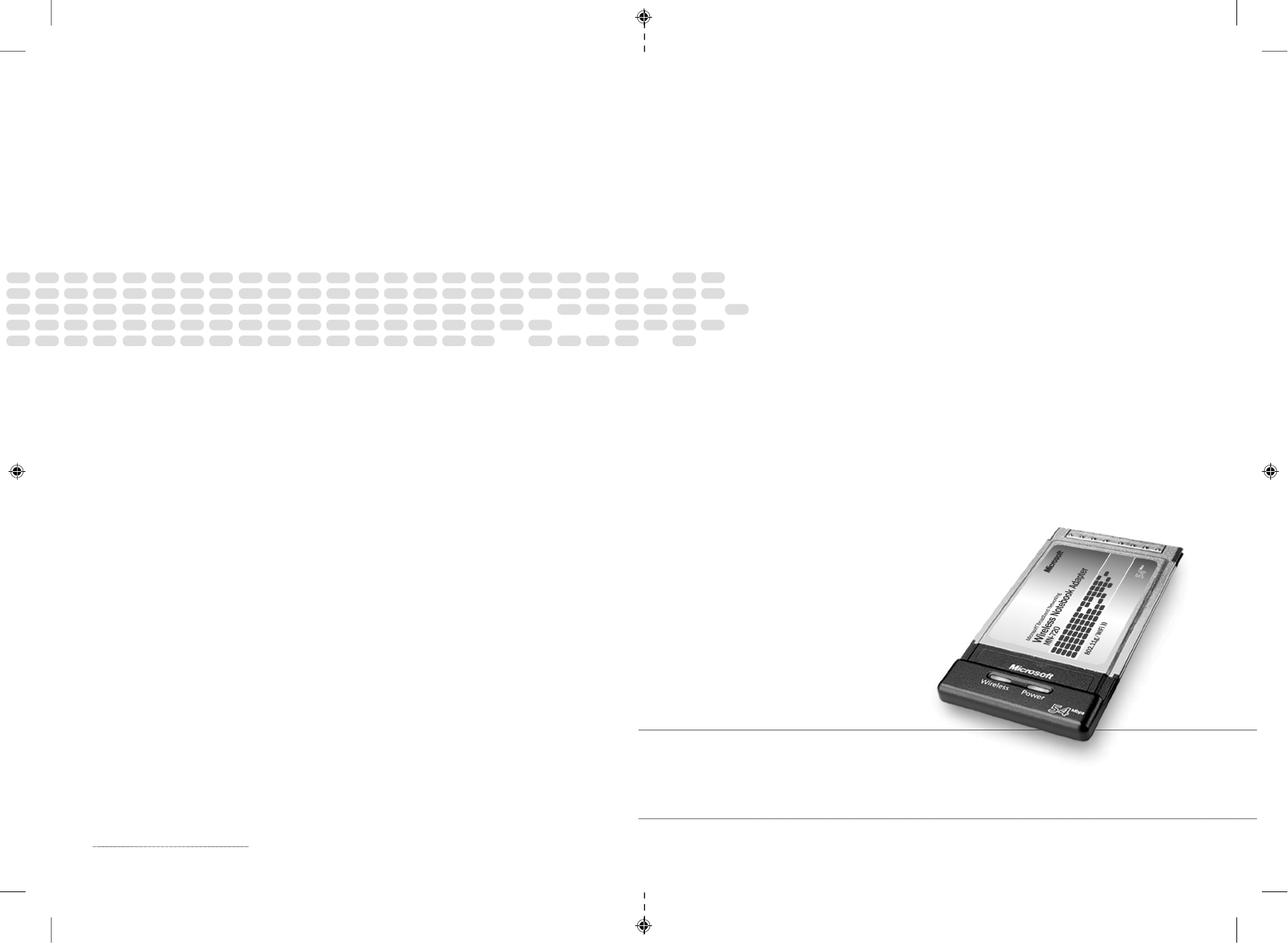Microsoft MN710 Broadband Wireless USB2.0 Adapter User Manual Cover
Microsoft Corporation Broadband Wireless USB2.0 Adapter Users Manual Cover
Contents
- 1. Users Manual
- 2. Users Manual Cover
Users Manual Cover

M
user’s guide
M
www.microsoft.com/broadbandnetworking
1203 Part No. X10-26439
Microsoft® Broadband Networking
Wireless-G Adapter
MN-710/MN-720
X1026439_CVR.indd 11/19/2003, 8:23 AM1

Caution
Any changes or modications not expressly approved by Microsoft could void the user’s
authority to operate this device.
Not intended for use in industrial, medical or scientic settings.
Do not use onboard an aircraft or in hazardous locations such as a gas station or other
explosive environment.
For indoor use only.
Notebook Adapter: This device has been tested for compliance with FCC RF Exposure
(SAR) limits in the typical laptop computer conguration and this device can be used in
desktop or laptop computers with side mounted PCMCIA slots. The antennas used with this
transmitter must not be co-located or operating in conjunction with any other antenna or
transmitter within the host device. Do not touch or re-orient the antenna while the device is
transmitting.
USB 2.0 adapter: Device should be located at least 20 cm (8 inches) away from any human
body in order to meet FCC exposure limits. The antennas used with this transmitter must
not be co-located or operating in conjunction with any other antenna or transmitter. Do not
touch or re-orient the antenna while the device is transmitting.
Attention
Tout changement ou modication apporté à ce dispositif non expressément autorisé par Microsoft
est à proscrire.
Ne pas utiliser ce dispositif dans une application industrielle, médicale ou scientique.
Ne pas utiliser dans un avion ou en présence de vapeur explosive (station-service).
N’utiliser qu’à l’intérieur.
Carte réseau pour ordinateur portable: Ce dispositif radio a été évalué pour son débit d’absorption
spécique (DAS) et respecte les limites d’exposition RF des personnes, telles que spéciées dans
la procédure CNR 102 lorsque utilisé dans le port PCMCIA d’un ordinateur portable ou de table.
Les antennes de ce dispositif transmetteur ne doivent ni être copositionnées ou ni utilisées en
conjonction avec quelque autre antenne ou transmetteur faisant partie de l ’ordinateur hôte. Ne
touchez pas à l’antenne lorsque l’appareil est en fonction.
Adaptateur USB: Ce dispositif doit être à plus de 20 cm (8 pouces) de toute personne. Les
antennes de ce dispositif transmetteur ne doivent ni être copositionnées ou ni utilisées en
conjonction avec quelque autre antenne ou transmetteur faisant partie de l ’ordinateur hôte. Ne
touchez pas à l’antenne lorsque l’appareil est en fonction.
Please retain this manual for future reference.
Veuillez conserver ce manuel pour future référence.
Information in this document, including URL and other Internet Web site references, is subject to change
without notice. Unless otherwise noted, the example companies, organizations, products, domain names,
e-mail addresses, logos, people, places, and events depicted herein are ctitious, and no association with
any real company, organization, product, domain name, e-mail address, logo, person, place, or event is
intended or should be inferred. Complying with all applicable copyright laws is the responsibility of the
user. Without limiting the rights under copyright, no part of this document may be reproduced, stored in,
or introduced into a retrieval system, or transmitted in any form or by any means (electronic, mechanical,
photocopying, recording, or otherwise), or for any purpose, without the express written permission of
Microsoft Corporation.
Microsoft may have patents, patent applications, trademarks, copyrights, or other intellectual property
rights covering subject matter in this document. Except as expressly provided in any written license
agreement from Microsoft, the furnishing of this document does not give you any license to these patents,
trademarks, copyrights, or other intellectual property.
© 2003 Microsoft Corporation. All rights reserved.
Microsoft and Windows are registered trademarks of Microsoft Corporation in the United States and/or
other countries.
UPnP is a trademark of UPnP Implementers Corp. Wi-Fi is a registered trademark and Wi-Fi Protected
Access is a trademark of Wi-Fi Alliance.
The names of actual companies and products mentioned herein may be the trademarks of their respective
owners.
My Network Settings
Use this page to record your network settings. For information about locating
these settings, see Appendix A.
Workgroup or domain name:
Base Station, gateway, or router password:
(Microsoft Base Station default password=admin)
Wireless Settings
Record the information used to congure a computer for wireless access to your
network here. All computers accessing your network with a wireless connection
need to use the same wireless settings.
Wireless network name (SSID):
WEP key or WPA passphrase:
Wireless channel (ad-hoc networks only):
Wide Area Network Settings
Complete this section only if your network has a base station (gateway or router).
You can obtain this information from your Internet service provider (ISP). Your ISP
may not require all of the settings listed below.
Dynamic IP (DHCP) Settings
Complete this section only if your ISP uses a DHCP connection.
Host name:
Adapter MAC address:
Static IP Address Settings
Complete this section only if your ISP has assigned you a specic IP address.
Static IP address:
Subnet mask:
IP gateway address:
Primary DNS server:
Secondary DNS server:
PPPoE Settings
Complete this section only if your ISP uses PPPoE.
User name:
Password:
Service name:
X1026439_CVR.indd 11/19/2003, 8:23 AM2